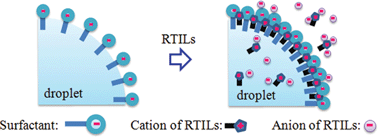Study of miniemulsion formulation containing 1-octyl-3-methylimidazolium hexafluorophosphate for its application in low-emitting coating products
Abstract
Room temperature ionic liquids (RTILs) are non-volatile organic salts, and few of them with low melting point may replace the conventional coalescing agents in waterborne coatings, thus preventing volatile organic compounds (VOCs) emission, caused by coalescing agents. The formation of waterborne coating containing RTILs can be achieved by the encapsulation of RTILs inside latexes via miniemulsion polymerization. Achieving a stable miniemulsion is a crucial step for further polymerization. In this study, 1-octyl-3-methylimidazolium hexafluorophosphate (C8mimPF6) was chosen, and various factors which might affect droplet size and its stability, including surfactant type, surfactant concentration, and C8mimPF6 concentration, were investigated. It was found that the presence of a small amount of C8mimPF6 coupled with the surfactant would offer marked effects on the droplet size reduction and droplet stability. Such effect may reach its maximum from 1 to 5 wt% C8mimPF6. Above the critical concentration, adding more C8mimPF6 to the oil phase may cause a larger initial droplet size as well as weaken the droplet stability. Such observations were consistent with the zeta potential measurements for miniemulsions prepared under similar conditions.


 Please wait while we load your content...
Please wait while we load your content...